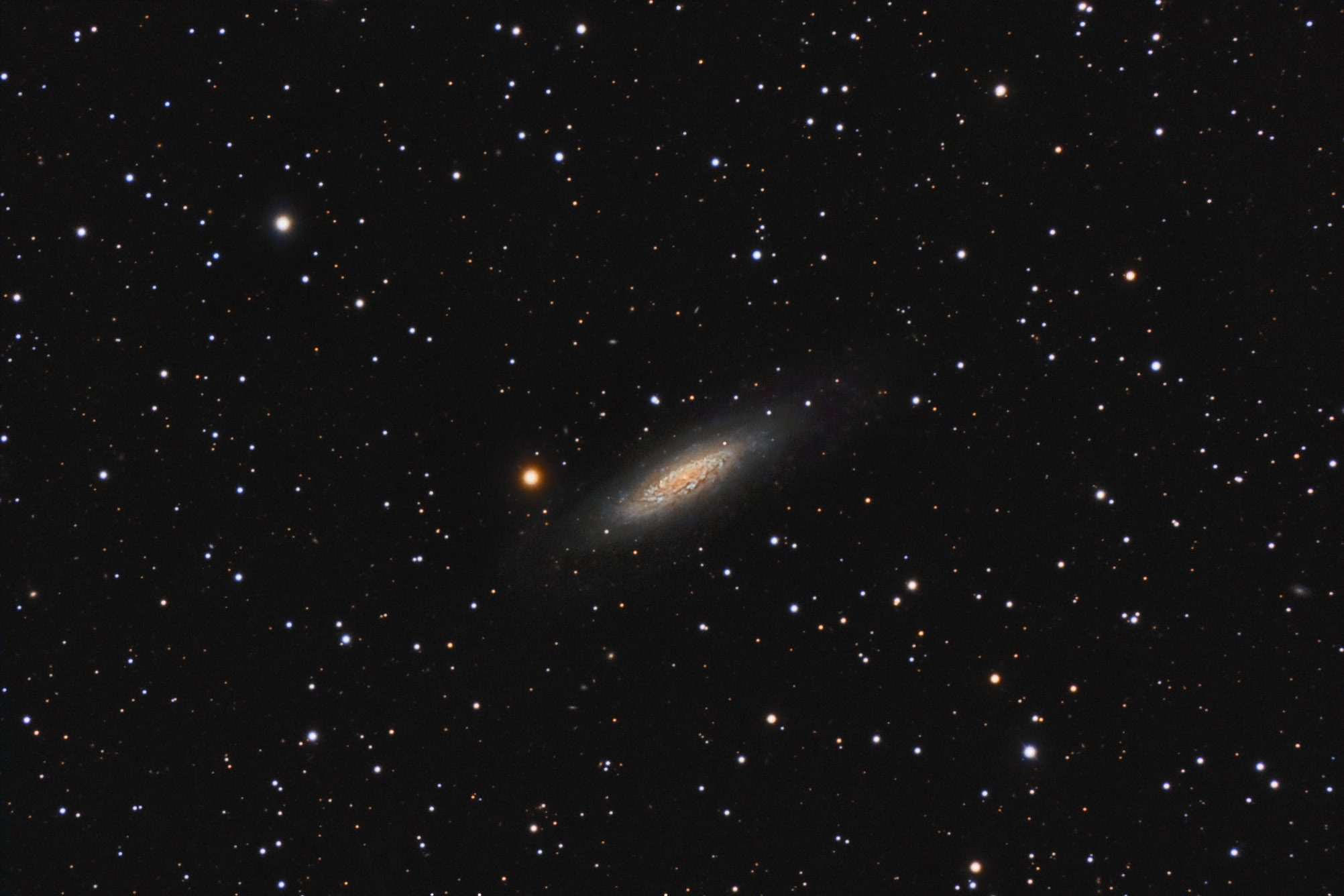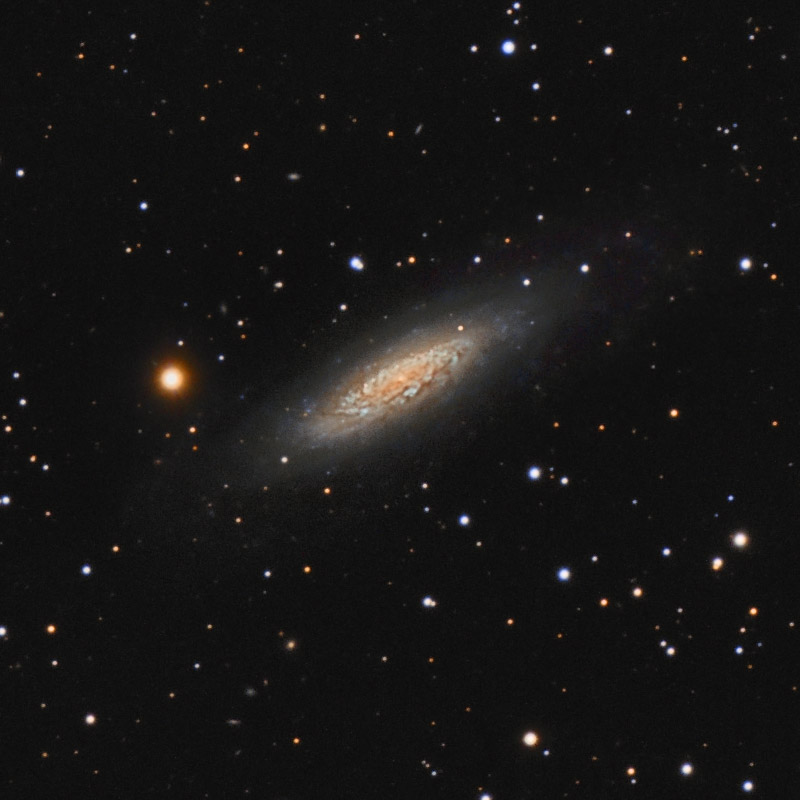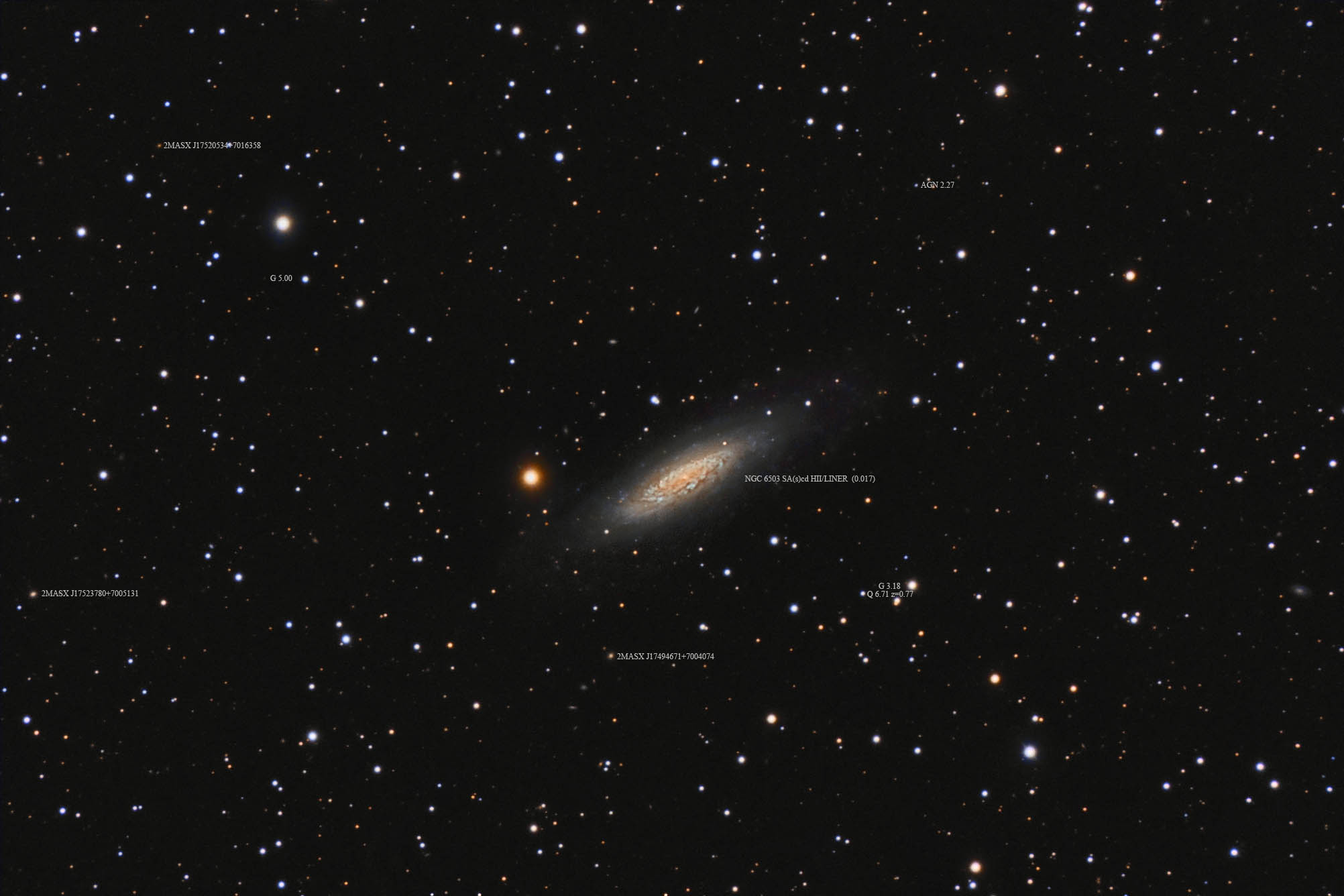Object name: NGC6503 NGC 6503 is a nice flocculent galaxy in eastern Draco and thought to be about 17 million light-years distant based on HST images of its red giant stars. Most sources call it a dwarf though NED doesn't. Nor should it in my opinion. Most sources give its diameter at 30 million light-years. I find that quite wrong. That is the diameter of its brighter disk but the disk extends considerably further both directions in my data. I find it nearly 10 minutes of arc across which makes it 49,000 light-years across. The faint extensions appear full of fuzzy objects. Since the HST image doesn't begin to go out far enough I don't know what these may be. Likely star clusters I would think. Some may be globulars I suppose but they seem to be in the disk making that unlikely. This is a very active galaxy with an active core and many star-forming HII regions. It was discovered on July 22, 1854 by Georg Friedrich Julius Arthur von Auwers using a 6.2" telescope.
The galaxy is on the edge of the "Local Void". This is a very poorly defined region bounded by our local group, the Hercules Cluster and some say the Coma Cluster. I have trouble with the latter as that is about half a billion light-years out so not exactly "local". The size of the void is given as somewhat between 30 and more than 150 million light-years. I'd say that is rather vague and rather a rather useless description. The void is said to contain fewer galaxies than would be expected there but with such a poor boundary I'd think you could "prove" about any density you wanted by playing with such a vague volume.
Being above (barely) the 70-degree limit I had for years I was unable to catch it. I wanted to try and see those HII regions. Finally, after my two Polaris trees had to be removed before they fell on the house or observatory I got the data. But not the HII data I had apparently planned on. The result was it was removed from my to-do list but not added to the to-process list though the data files had been moved into that directory. Without going on the listing it sat there ignored. After a request was put out for the image some time ago I looked and saw the data was waiting to be processed but never noticed it wasn't in the queue to actually be processed. I mentioned I had the data but it would be a while before I got to it as I looked down the listing for two months and didn't see it. Finally, I wondered when I would get to it so looked down the full list and it wasn't there. So years late I finally made a rush to process the data even though there's no H alpha data. Apparently, I was planning on getting that but not putting it in the to-do queue at all let alone at a high priority that never happened. If the weather ever clears here I'll see if I can remedy that.
Also, I found the red data was poor. It got hit by clouds and hurt badly. That I noticed and I retook the data or tried to later that night after it cleared. But instead of taking red data I took blue! This one just wasn't meant to be. I struggled but think I sort of salvaged the color even with this handicap.
There's not much on this field. Some of the obvious galaxies are strong Ultraviolet emitters and were cataloged by the GALEX ultraviolet space telescope. Oddly NED picks them up only as UV sources of an unknown nature rather than as the galaxy they are. None have redshift data so I didn't note them on the annotated image. I did note all galaxies NED listed as galaxies, however. Since these are only known by their coordinates I didn't bother to identify them beyond their status as G for galaxy AGN for active galactic nucleus and Q for quasar. Somehow three from the 2MASS survey without distance info did get fully identified. Why I don't know. I'm dead tired after two hard days splitting many cords of super heavy oak. That's my excuse and I'm sticking to it. I'm too old to be lifting 100 lb. hunks onto a splitter. I need one with a hydraulic lift. Some are over 30" across.
14" LX200R @ f/10, L=4x10' RG=2x10' B=4x10', STL-11000XM, Paramount ME
RickNGC 6503 is a nice flocculent galaxy in eastern Draco and thought to be about 17 million light-years distant based on HST images of its red giant stars. Most sources call it a dwarf though NED doesn't. Nor should it in my opinion. Most sources give its diameter at 30 million light-years. I find that quite wrong. That is the diameter of its brighter disk but the disk extends considerably further both directions in my data. I find it nearly 10 minutes of arc across which makes it 49,000 light-years across. The faint extensions appear full of fuzzy objects. Since the HST image doesn't begin to go out far enough I don't know what these may be. Likely star clusters I would think. Some may be globulars I suppose but they seem to be in the disk making that unlikely. This is a very active galaxy with an active core and many star-forming HII regions. It was discovered on July 22, 1854 by Georg Friedrich Julius Arthur von Auwers using a 6.2" telescope.
The galaxy is on the edge of the "Local Void". This is a very poorly defined region bounded by our local group, the Hercules Cluster and some say the Coma Cluster. I have trouble with the latter as that is about half a billion light-years out so not exactly "local". The size of the void is given as somewhat between 30 and more than 150 million light-years. I'd say that is rather vague and rather a rather useless description. The void is said to contain fewer galaxies than would be expected there but with such a poor boundary I'd think you could "prove" about any density you wanted by playing with such a vague volume.
Being above (barely) the 70-degree limit I had for years I was unable to catch it. I wanted to try and see those HII regions. Finally, after my two Polaris trees had to be removed before they fell on the house or observatory I got the data. But not the HII data I had apparently planned on. The result was it was removed from my to-do list but not added to the to-process list though the data files had been moved into that directory. Without going on the listing it sat there ignored. After a request was put out for the image some time ago I looked and saw the data was waiting to be processed but never noticed it wasn't in the queue to actually be processed. I mentioned I had the data but it would be a while before I got to it as I looked down the listing for two months and didn't see it. Finally, I wondered when I would get to it so looked down the full list and it wasn't there. So years late I finally made a rush to process the data even though there's no H alpha data. Apparently, I was planning on getting that but not putting it in the to-do queue at all let alone at a high priority that never happened. If the weather ever clears here I'll see if I can remedy that.
Also, I found the red data was poor. It got hit by clouds and hurt badly. That I noticed and I retook the data or tried to later that night after it cleared. But instead of taking red data I took blue! This one just wasn't meant to be. I struggled but think I sort of salvaged the color even with this handicap.
There's not much on this field. Some of the obvious galaxies are strong Ultraviolet emitters and were cataloged by the GALEX ultraviolet space telescope. Oddly NED picks them up only as UV sources of an unknown nature rather than as the galaxy they are. None have redshift data so I didn't note them on the annotated image. I did note all galaxies NED listed as galaxies, however. Since these are only known by their coordinates I didn't bother to identify them beyond their status as G for galaxy AGN for active galactic nucleus and Q for quasar. Somehow three from the 2MASS survey without distance info did get fully identified. Why I don't know. I'm dead tired after two hard days splitting many cords of super heavy oak. That's my excuse and I'm sticking to it. I'm too old to be lifting 100 lb. hunks onto a splitter. I need one with a hydraulic lift. Some are over 30" across.
14" LX200R @ f/10, L=4x10' RG=2x10' B=4x10', STL-11000XM, Paramount ME
Rick Related Designation(s):11HUGS 395, 1RXS J174925.9+700840, 1WGA J1749.4+7008, 2H 1749+707, 2MASS J17492642+7008395, 2MASX J17492651+7008396, 2MASXi J1749271+700839, 2MIG 2437, AKARI J1749244+700842, CGCG 1749.9+7010, CGCG 340-019, CXO J174926.4+700839, CXO J174926.43+700839.7, IRAS 17499+7009, IRAS F17499+7009, ISOSS 086, ISOSS J17493+7009, KIG 0837, MCG +12-17-009, NGC 6503, NGC 6503:[L2011a] X0010, NGC 6503:[LJL2007] b, NGC6503, PGC 060921, UGC 11012, UZC J174926.3+700842, WN B1750+7009, [CHP2004] J174926.4+700840, [RHM2006] SFGs 016, [SLK2004] 1401, [SPB93] 259, | | 

